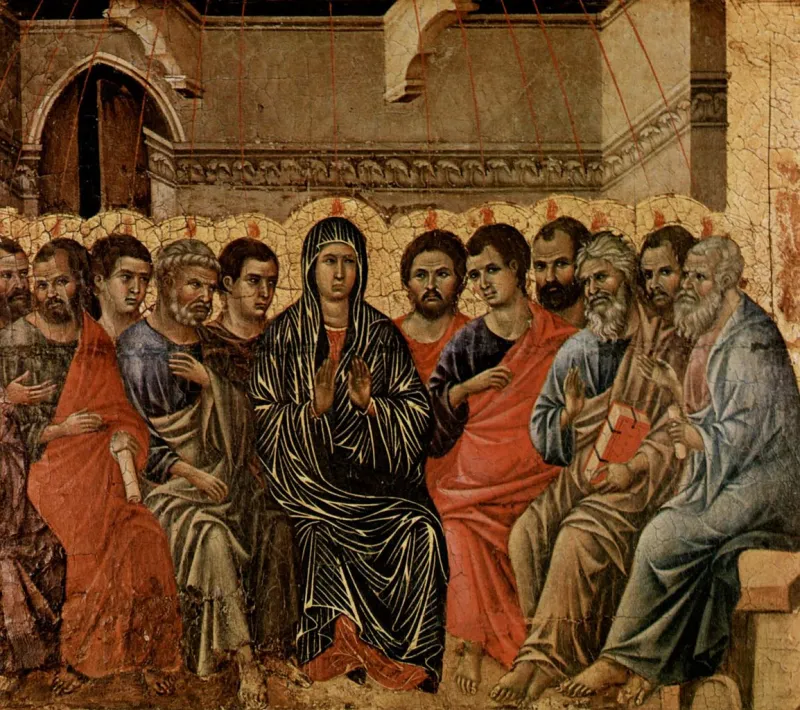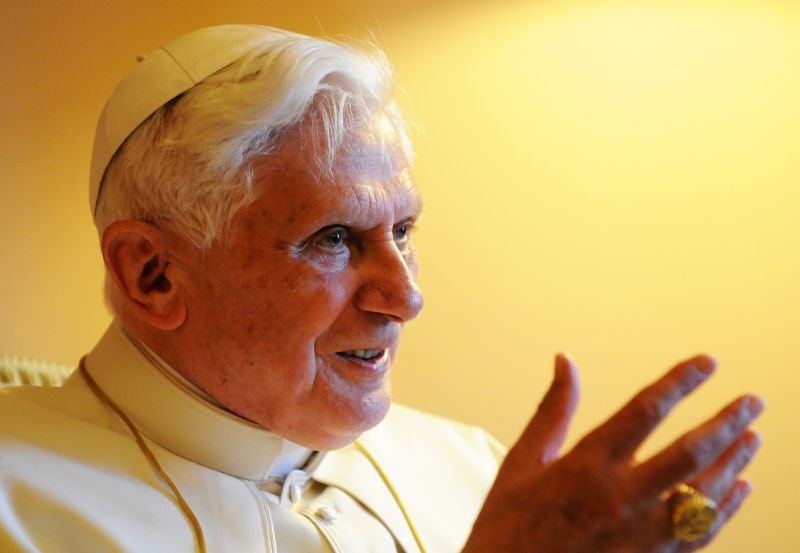 Duccio’s Pentecost (1308) / public domain
Duccio’s Pentecost (1308) / public domain
Washington, D.C. Newsroom, May 27, 2022 / 16:00 pm (CNA).
The first novena ever prayed is the Pentecost Novena, or the Novena to the Holy Spirit. This year, it begins on Friday, May 27, and concludes on Saturday, June 4.
Catholics worldwide often recite the novena during the nine days that fall between the feast of the Ascension, when Christ rises body and soul to heaven, and the feast of Pentecost, when the Holy Spirit comes upon the apostles, Mary, and the first followers of Christ.
This year, Pentecost falls on June 5.
The prayer recalls and invites Catholics to participate in the nine days that the Blessed Virgin Mary and the apostles spent in prayer after Christ ascended into heaven. Together, they prayed in Jerusalem in anticipation of the Holy Spirit’s coming, which Christ had promised them.
The word “novena” is derived from the Latin word for nine. Catholics will frequently pray a novena — a prayer repeated once a day for nine days — for a particular intention. This novena asks for the Holy Spirit’s seven gifts: wisdom, understanding, counsel, fortitude, knowledge, piety, and fear of the Lord.
There are many versions of this novena, including one derived from the “The Sanctifier” by Servant of God Luis Maria Martinez, Archbishop of Mexico from 1937 to 1956, and made available by the Daughters of St. Paul.
The Archdiocese of Denver recommends the one below, adapted from novenas found on Adoremus.org and Angeluspress.org.
End each day with the following prayer for all seven gifts:
O Lord Jesus Christ who, before ascending into heaven, promised to send the Holy Spirit to finish your work in the souls of your apostles and disciples, be pleased to grant the same Holy Spirit to me that he may perfect in my soul the work of your grace and love. Grant me the spirit of wisdom, that I may despise the perishable things of this world and aspire only after the things that are eternal; the spirit of understanding to enlighten my mind with the light of your divine truth; the spirit of counsel that I may ever choose the surest way of pleasing God and gaining heaven; the spirit of fortitude that I may bear my cross with you and that I may overcome all obstacles that oppose my salvation; the spirit of knowledge that I may know God and know myself in him; the spirit of piety that I may find the service of God sweet and pleasurable; the spirit of fear of the Lord that I may be filled with a loving reverence towards God and may dread in any way to offend him. Animate me in all things with your spirit. Amen.
Day 1: Prayer for the Seven Gifts of the Holy Spirit
Holy Spirit, Lord of Light,
from the clear celestial height,
thy pure beaming radiance give.
Come Holy Spirit, fill the hearts of your faithful and kindle in them the fire of your divine love. Send forth your spirit and they shall be created, and you shall renew the face of the earth. O God, who has taught the hearts of the faithful by the light of the Holy Spirit, grant that by the gift of the same Spirit we may always be truly wise and ever rejoice in His consolation. Through Christ our Lord. Amen.
Day 2: Prayer for the Gift of Holy Fear
Come thou father of the poor,
come with treasures which endure,
come thou light of all that live.
Come, O blessed Spirit of Holy Fear, penetrate my inmost heart, that I may set you, my Lord and God, before my face forever; help me to shun all things that can offend you, and make me worthy to appear before the pure eyes of your Divine Majesty in heaven, where you live and reign in the unity of the Blessed Trinity, God, world without end. Amen.
Day 3: Prayer for the Gift of Piety
Thou of all consolers best,
visiting the troubled breast,
dost refreshing peace bestow.
Come, O blessed Spirit of Piety, possess my heart. Implant in my soul filial love toward God my heavenly Father, and brotherly love for all, so that I may delight in the service of God and my neighbor. Amen.
Day 4: Prayer for the Gift of Fortitude
Thou in toil art comfort sweet,
pleasant coolness in the heat,
solace in the midst of woe.
Come of blessed Spirit of Fortitude, uphold my soul in time of trouble and adversity, sustain my efforts after holiness, strengthen my weakness, give me courage against all the assaults of my enemies, that I may never be overcome and separated from you, my God and greatest Good. Amen.
Day 5: Prayer for the Gift of Knowledge
Light immortal, light divine,
visit thou these hearts of thine,
and our inmost being fill.
Come, O blessed Spirit of Knowledge, and grant that I may perceive the will of the Father; show me the nothingness of earthly things, that I may realize their vanity and use them only for your glory and my own salvation, looking ever beyond them to you and your eternal rewards. Amen.
Day 6: Prayer for the Gift of Understanding
If thou take thy grace away,
nothing pure in man will stay;
all his good is turned to ill.
Come, O Spirit of Understanding, and enlighten our minds that we may know and believe all the mysteries of salvation; and may merit at last to see the eternal light in your light; and in the light of glory to have a clear vision of you, the Father, and the Son. Amen.
Day 7: Prayer for the Gift of Counsel
Heal our wounds, our strength renew;
on our dryness pour thy dew;
wash the stains of guilt away.
Come, O Spirit of Counsel, help and guide me in all my ways, that I may always do your holy will. Incline my heart to that which is good; turn it away from all that is evil and direct me by the straight path of your commandments to that goal of eternal life for which I long. Amen.
Day 8: Prayer for the Gift of Wisdom
Bend the stubborn heart and will,
melt the frozen, warm the chill,
guide the steps that go astray.
Come, O Spirit of Wisdom, and reveal to my soul the mysteries of heavenly things, their exceeding greatness, power, and beauty. Teach me to love them above and beyond the passing joys and satisfactions of earth. Help me to attain them and possess them forever. Amen.
Day 9: Prayer for the Fruits of the Holy Spirit
Thou on those who evermore,
thee confess and thee adore,
in thy sevenfold gift descend.
Give them comfort when they die,
give them life with thee on high,
give them joys which never end.
Come, O Divine Spirit, fill my heart with your heavenly gifts: your charity, joy, peace, patience, kindness, generosity, faithfulness, gentleness, and self-control, that I may never weary in the service of God, but by continued faithful submission to your inspiration may merit to be united eternally with you in the love of the Father and the Son. Amen.
[…]






Leave a Reply